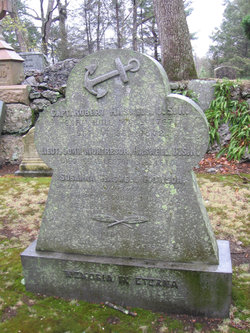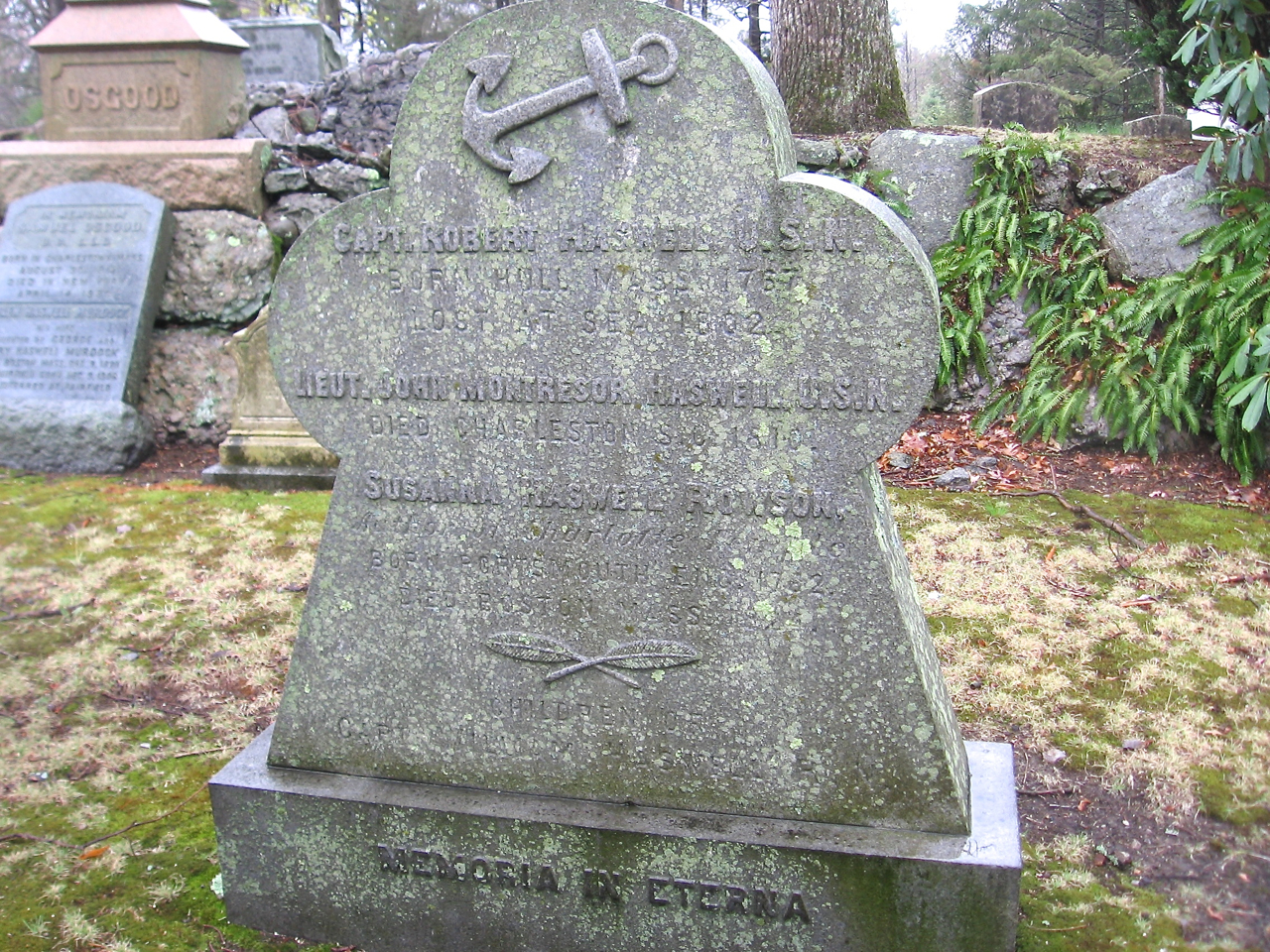Susanna also wrote a number of other works, such as novels, plays, poetry, and song lyrics. Many of her works are now available online for anyone interested in reading them. She was also the first woman editor of The Boston Weekly Magazine and published a number of essays in New England Galaxy.
Susanna's mother, Susanna (nee Musgrave or Musgrove) Haswell, died from complications of giving birth to her. Her father, William Haswell, was in the Royal Navy and came to Massachusetts Colony on his own, initially leaving her in England. When she was five (some sources say four), she came to join her father and stepmother in Nantasket (now Hull), Massachusetts, and her ship was one of many shipwrecked on Lovells Island in Boston Harbor, within sight of Boston. Susanna was lucky to be rescued by fishermen living on the islands; many of those shipwrecked on Lovells died before rescuers were able to reach them. Susanna's stepmother, Massachusetts native Rachel (Woodward) Haswell, gave birth to at least two children in Massachusetts, Robert and John.
After the Revolution began, Susanna's father's property in the colonies was confiscated and in 1778 the family returned to England. Susanna worked to help support her family, becoming governess for the Duchess of Devonshire, who became patron for Susanna's first novel, Victoria, published in 1786. Also in 1786 she married William Rowson of London, who was a merchant and a trumpeter in the Royal Horse Guards. In 1792 William went bankrupt, and Susanna turned to the theater to help support her family, usually appearing with her husband. They performed in Edinburgh, where some sources say Thomas Wignell first saw them act. In 1793 Thomas Wignell asked Susanna and William if they would like to join his company opening in Philadelphia, named the New Theatre Company, and they accepted the offer and moved to what was now the United States. By the end of the year she had finished her first play, which was scored by well-known composer Alexander Reinagle, and her play, titled Slaves in Algiers, or A Struggle for Freedom, opened the following year as a hit.
In 1796 Susanna moved to Boston to join the Federal Street Theatre Company. The next year Susanna left the theater to found Mrs. Rowson's Young Ladies' Academy on Temple Street in Boston, which she ran herself, including introducing what is said to have been Boston's first pianoforte. Though the school initially was located in Boston, it moved to a couple of then-suburbs (High Street in Medford and Nonantum Corner in Newton) before returning to Boston (first to Washington Street, then to Hollis Street). The school started out primarily attracting students from New England. As the school's reputation and enrollment grew, students came from around the young United States as well as some from other countries. Susanna used her writing skills to write textbooks for her school. A partial list of her students is at the back of the biography A Memoir of Mrs. Susanna Rowson, with Elegant and Illustrative Extracts from Her Writings in Prose and Poetry by Elias Nason (Albany, NY: Joel Munson, 1870).
Susanna had no biological children; she raised her husband's sister Charlotte, his 'illegitimate' son William, and an adopted daughter. Susanna retired from running the school in 1822 and gave it to her niece and her adopted daughter to run. In 1824 she died at her home on Hollis Street in Boston.
The University of Virginia has an extensive collection of Susanna's papers as well as some other Rowson/Haswell family materials and research Elias Nason did for his biography of Susanna. See their finding aid for more information.
The monument at Forest Hills is a cenotaph to her and her brothers. (In other words, though she and her brothers are commemorated here, they aren't buried here.) After Susanna's death, her body was initially placed in the family vault of her friend, the composer and fellow Boston immigrant Johann Christian Gottlieb Graupner, at St. Matthew's Church in South Boston, but when the church was demolished, everyone's remains were placed in a mass grave in Mount Hope Cemetery in Boston. As far as I am aware, the cenotaph here at Forest Hills is the only stone monument commemorating Susanna's memory.
Susanna also wrote a number of other works, such as novels, plays, poetry, and song lyrics. Many of her works are now available online for anyone interested in reading them. She was also the first woman editor of The Boston Weekly Magazine and published a number of essays in New England Galaxy.
Susanna's mother, Susanna (nee Musgrave or Musgrove) Haswell, died from complications of giving birth to her. Her father, William Haswell, was in the Royal Navy and came to Massachusetts Colony on his own, initially leaving her in England. When she was five (some sources say four), she came to join her father and stepmother in Nantasket (now Hull), Massachusetts, and her ship was one of many shipwrecked on Lovells Island in Boston Harbor, within sight of Boston. Susanna was lucky to be rescued by fishermen living on the islands; many of those shipwrecked on Lovells died before rescuers were able to reach them. Susanna's stepmother, Massachusetts native Rachel (Woodward) Haswell, gave birth to at least two children in Massachusetts, Robert and John.
After the Revolution began, Susanna's father's property in the colonies was confiscated and in 1778 the family returned to England. Susanna worked to help support her family, becoming governess for the Duchess of Devonshire, who became patron for Susanna's first novel, Victoria, published in 1786. Also in 1786 she married William Rowson of London, who was a merchant and a trumpeter in the Royal Horse Guards. In 1792 William went bankrupt, and Susanna turned to the theater to help support her family, usually appearing with her husband. They performed in Edinburgh, where some sources say Thomas Wignell first saw them act. In 1793 Thomas Wignell asked Susanna and William if they would like to join his company opening in Philadelphia, named the New Theatre Company, and they accepted the offer and moved to what was now the United States. By the end of the year she had finished her first play, which was scored by well-known composer Alexander Reinagle, and her play, titled Slaves in Algiers, or A Struggle for Freedom, opened the following year as a hit.
In 1796 Susanna moved to Boston to join the Federal Street Theatre Company. The next year Susanna left the theater to found Mrs. Rowson's Young Ladies' Academy on Temple Street in Boston, which she ran herself, including introducing what is said to have been Boston's first pianoforte. Though the school initially was located in Boston, it moved to a couple of then-suburbs (High Street in Medford and Nonantum Corner in Newton) before returning to Boston (first to Washington Street, then to Hollis Street). The school started out primarily attracting students from New England. As the school's reputation and enrollment grew, students came from around the young United States as well as some from other countries. Susanna used her writing skills to write textbooks for her school. A partial list of her students is at the back of the biography A Memoir of Mrs. Susanna Rowson, with Elegant and Illustrative Extracts from Her Writings in Prose and Poetry by Elias Nason (Albany, NY: Joel Munson, 1870).
Susanna had no biological children; she raised her husband's sister Charlotte, his 'illegitimate' son William, and an adopted daughter. Susanna retired from running the school in 1822 and gave it to her niece and her adopted daughter to run. In 1824 she died at her home on Hollis Street in Boston.
The University of Virginia has an extensive collection of Susanna's papers as well as some other Rowson/Haswell family materials and research Elias Nason did for his biography of Susanna. See their finding aid for more information.
The monument at Forest Hills is a cenotaph to her and her brothers. (In other words, though she and her brothers are commemorated here, they aren't buried here.) After Susanna's death, her body was initially placed in the family vault of her friend, the composer and fellow Boston immigrant Johann Christian Gottlieb Graupner, at St. Matthew's Church in South Boston, but when the church was demolished, everyone's remains were placed in a mass grave in Mount Hope Cemetery in Boston. As far as I am aware, the cenotaph here at Forest Hills is the only stone monument commemorating Susanna's memory.
Inscription
CAPT. ROBERT HASWELL U.S.N.
BORN HULL MASS. 1767
LOST AT SEA 1802
LIEUT. JOHN MONTRESOR HASWELL U.S.N.
DIED CHARLESTON S.C. 1810.
SUSANNA HASWELL ROWSON.
Author of Charlotte Temple
BORN PORTSMOUTH ENG. 1762.
DIED BOSTON MASS. 1824.
CHILDREN OF
CAPT. WILLIAM HASWELL R.N.
MEMORIA IN ETERNA
Gravesite Details
Cenotaph. Damaged by lichen.
Advertisement
Explore more
Sponsored by Ancestry
Advertisement



